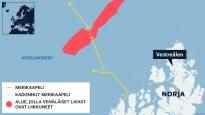According to the Norwegian Broadcasting Corporation, several Russian fishing vessels were in the area at the time of the disappearance of Vesterålen’s oceanographic cable and the disruption of the Svalbard satellite cable.
The Norwegian broadcasting company NRK has investigated the shipping traffic in the northern regions, where the undersea communication cables were damaged for reasons unknown so far. The first of the damages occurred at the beginning of last year, the second at the turn of the year.
Last winter, reported on mysterious disappearances of cables and communication interruptions in Finland. Suspicions of intentional activity were also reported.
NRK’s statement (you switch to another service)of trawlers’ movements is based on data from the ships’ AIS system collected by the Norwegian Maritime Administration. The system can be used to determine the exact movements of ships.
AIS is an automatic system based on satellite tracking that collects and transmits ship identification information, position, movements and speed.
Ships have transponders similar to airplanes. With the help of the information transmitted by the transmitters, the precise movements of the ships can be determined.
Vesterålen’s cable in the service of science and intelligence
On April 3, 2021, the data stream of a research cable off the coast of northern Norway, off the Vesterålen archipelago, was suddenly interrupted.
It was later revealed that the 4.2 kilometer long and several ton weight cable section of the Norwegian Institute of Marine Research mysteriously disappeared in the depths of the seas.
The cable’s task is to transmit information about the depths of the sea to researchers, for example about migrating shoals of sei and cod.
According to NRK, the Research Institute of the Norwegian Defense Forces screens the data recorded by the research cable for information of interest to intelligence. They include, for example, the sounds of submarines, which can be used to identify ships.
At the time of the disappearance of the research cable on Easter, there were only Russian fishing vessels in the area, according to NRK’s investigation.
Data from the AIS system indicated that the Russian trawler Saami had crossed the Vesterålen survey cable when the connection was lost and the cable was lost. The lost cable was found half a year later 11 kilometers from its original location.
A representative of the Saami trawler replied to NRK that the vessel had been in the area and had taken care of the known cable. According to the representative, it was unlikely that the cable would have caught the trawler.
The summit cable transmits satellite data to the world
Three of the Russian ships that were in the Vesterålen sea area at the time of the cable’s disappearance were also months later in the waters of Svalbard, when one of the two seabed satellite cables broke there for an unknown reason on January 7, 2022.
According to NRK, these three Russian ships were Sevryba, Yagry and Vitus Bering. In addition, there were other Russian trawlers in the area.
The NRK story says that on the day of the damage to the Viippuvuorti satellite cable and the following day, the Russian trawler Melkart 5 crossed the cable no less than 20 times.
Representatives of the Russian trawlers have denied to NRK that they had anything to do with the cable damage. According to them, the cable has been taken care of and the fishing has been legal.
According to the shipping company, Melkart and the other ships answered the Norwegian Coast Guard’s questions about the cable and the answer was accepted.
The Norwegian trawling expert marvels at the lively ride on the cables
– The cables are marked on the Norwegian sea charts, and the trawlers watch out for them, says an expert in sea trawling interviewed by NRK Roger B. Larsenwho studies fishing techniques at the University of Tromssa.
Larsen wonders why Russian fishing vessels have been fishing near the cables.
– Completely incomprehensible that someone would trawl over submarine cables like that. It is unusual that some vessels have trawled over these cables repeatedly, says Larsen.
Fishing on top of the cables is not prohibited, but according to the expert, it has always been avoided because the trawl can get caught in the cable.
The Norwegian police are silent, the Russian embassy was upset
Norway’s intelligence service has previously warned that Russia is developing its attack capability against underwater facilities in the Atlantic and this is a serious threat to undersea cables.
During the winter, the Norwegian police considered it possible that the cable damage was caused by human activity and not by natural forces.
Neither the police nor other authorities have commented on NRK’s report or the information it revealed about the movements of Russian trawlers. The authorities cite the sensitive nature of the information.
In the reply of the Russian embassy in Oslo to NRK, it is accused that the Norwegian media has for a long time unjustifiably slandered everything possible related to Russia.
What thoughts did the story evoke? You can participate in the discussion with Tunnus 4.7. until 11 p.m.
NRK’s article used as a source:
